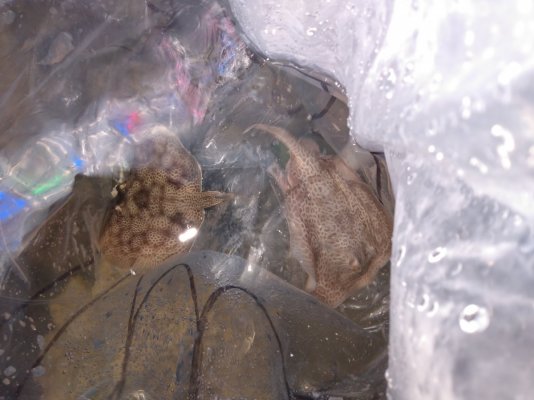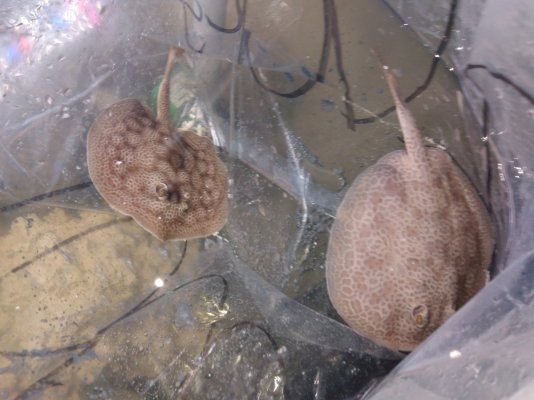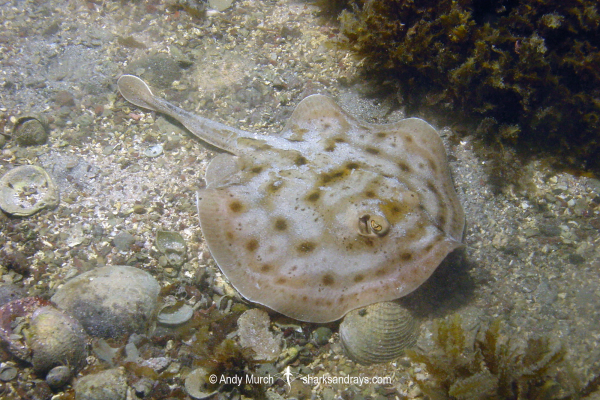Two Round stingrays I once found being sold as "Cortez stingrays"
In this rant, I will discuss the Cortez stingray (Urobatis maculatus), otherwise known as the Cortez round stingray, the Cortez ray, the Chocolate chip ray, and the Spotted round ray.
OH MY GOODNESS! 99.9% of the time I find so called "Cortez stingrays" being owned by hobbyists or sold by vendors, they actually turn out to be Round stingrays (Urobatis halleri). I know the two can be somewhat difficult to differentiate, their distributions overlap (including within the Sea of Cortez), and their care requirements are basically identical, but I cannot believe that this misidentification remains so prevalent. They just appear SOOO distinct!
Take a look for yourselves:
True Cortez stingrays:
https://sharksandrays.com/wp-content/uploads/2021/04/Cortez-Round-Stingray-047.jpg
https://static.inaturalist.org/photos/2862443/large.jpg?1452375179
https://biogeodb.stri.si.edu/sftep/resources/img/images/species/232_6015.jpg
Round stingrays:
https://biogeodb.stri.si.edu/sftep/resources/img/images/species/231_6325.jpg
https://upload.wikimedia.org/wikipedia/commons/e/ed/Round_stingray.jpg
https://c8.alamy.com/comp/B75YWC/round-stingray-urobatis-halleri-captive-B75YWC.jpg
And here are the some images of "Cortez stingrays" in aquariums:
https://forums.saltwaterfish.com/data/f/fc/fc4cc467_stingray.jpeg
https://scontent-sjc3-1.xx.fbcdn.ne...=95d7bc98f48bd7c816382dc5ab837794&oe=613714C0
https://preview.redd.it/pgibxfj69st...bp&s=fe57b3437984b8f888e930cc09689c8f24848b63
https://www.aquariumadvice.com/forums/attachment.php?attachmentid=213149&thumb=1&d=1387755855
https://i0.wp.com/harrysmarinelife....1/03/img_5691-scaled.jpeg?fit=2560,2560&ssl=1
http://www.wetwebmedia.com/CartilaginousFishesPIX/Rays/Urlolophidae/Cortez ray ishs (1).jpg
See what I mean? Those are definitely Round stingrays! While the two share a similar body type and similar coloration (light tan to dark brown), the Round stingray lacks the regularly spaced black spots of the Cortez stingray (instead possessing none or very few irregularly spaced spots as shown here: https://upload.wikimedia.org/wikipedia/commons/3/37/Round_stingray_reiman.jpg). It also features two overlapping reticulating patterns on its back (one resembling a large honeycomb while the other resembles a multitude of small dots) while the Cortez stingray features only one (the large honeycomb).
To be true, I have seen Cortez stingrays being identified correctly in home aquaria/for sale (here are the only two examples I know of)...
A lone specimen: https://scontent-sjc3-1.xx.fbcdn.ne...=a7d6438ce2a885f8eb49f767c004c98d&oe=61359610
Paired with a Round stingray (the Cortez stingray is on top): http://reefcentral.com/gallery/data/500/119348Rays.jpg
...however, a number this low seems absurdly unreasonable to me.
Also, on an additional note, I find other ray species being misidentified with the Cortez stingray to a lesser extent which I only find... moderately distressing. Here's a list with example pictures of misidentifications:
Leopard round stingray (Urobatis pardalis)
https://www.aquariumdomain.com/images/speciesProfiles/CortezRoundRay6.jpg
Chilean round stingray (Urotrygon chilensis)
https://cdn.shopify.com/s/files/1/1141/1330/products/Cortez-Stingray.jpg?v=1582325935
And that's just about it...
Sorry for the rant, but this issue has been bugging me for so long (3 years?) and I wanted to get the word out.






















